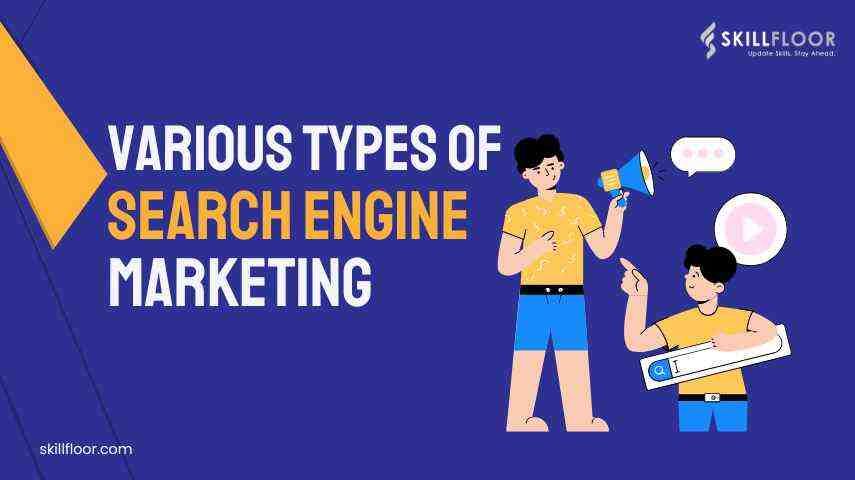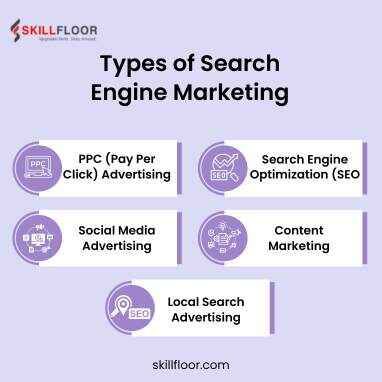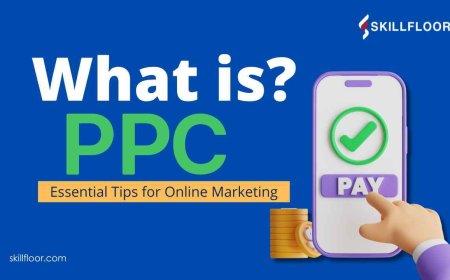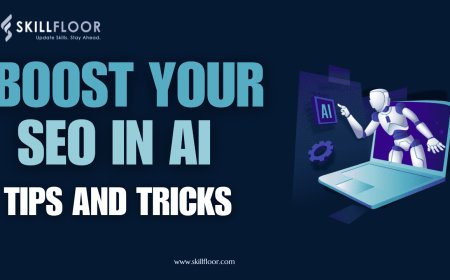Exploring Types of Search Engine Marketing
Discover various types of search engine marketing (SEM) to boost online visibility and drive traffic. Learn strategies for effective digital marketing campaigns.

It wasn't very clear when I first started learning about digital marketing. But after I enrolled in a digital marketing course, everything changed. I learned about topics like SEO, social media, and analytics from the course, which was clear and easy to understand. I realized how important it is to base choices on data when I put what I had learned into practice. While it wasn't always simple, each challenge improved me. I now use everything I've learnt to develop successful online strategies and continue developing in this ever-changing field. Search engine marketing, or SEM, was just beginning to develop success when I started. It is now a key element of any successful online marketing strategy. The reason is simple: if someone needs online information, goods, or services, they go to search engines. Let's go through the types of search engine marketing (SEM) along with some advice and examples. My choice was up over the years from working in the field.
Understanding Search Engine Marketing
It's important to understand search engine marketing (SEM) before looking into the types of search engine marketing. SEM is a type of digital marketing that involves using paid advertising to increase a website's exposure in search engine results pages (SERPs). Search engine optimization (SEO), which aims to raise organic search ranks, is not the same as this strategy. Instead, pay-per-click (PPC) advertising and other forms of paid search ads are the foundation of SEM.
Understanding Search Engine Optimization
Increasing higher visibility for your website on search engines like Google is the main goal of SEO or search engine optimization. It includes improving website content, using the right keywords, and making sure your website is simple to use. By doing this, when people look for information, goods, or services connected to what you provide, your website may show up higher in search results. SEO is about regular, consistent work to increase the relevancy and user experience of your website rather than fast fixes. Good SEO will eventually increase the number of people who visit your website and interact with your content.
The Importance of Search Engine Marketing
It is impossible to overvalue the importance of SEM. Businesses have an excellent chance to reach potential customers at the exact moment they are searching for something related to their products or services, due to the billions of searches that are made on platforms like Google every day. With this targeted approach, you can be sure that your marketing is more successful in bringing relevant traffic to your website and increasing conversion rates.
Types of Search Engine Marketing
Let's now explore the many forms of search engine marketing and their practical applications.

1. PPC (Pay Per Click) Advertising
Significantly the most common type of search engine marketing is pay-per-click advertising. It involves bidding on industry-relevant keywords, and you are charged a fee each time a user clicks on your advertisement. The most widely used platform for PPC advertising is Google Ads. Marked as "Ads" to differentiate them from organic results, these advertisements show up at the top of search engine results pages.
For example, if you own a bakery and place a bid on the term "best chocolate cake," those who search for that term may see your advertisement. They can visit your website to learn more about your products or make a purchase after clicking on your advertisement.
-
Research on Keywords
This involves identifying the terms or expressions that users enter into search engines to find products or services similar to yours. For your advertising to appear when people search for certain terms, you need to be aware of them.
-
Ad Creation
You make advertising after you get the keywords. This involves creating compelling copy and, if necessary, including visuals to get readers to click on your advertisement.
-
Bid Management
Each time someone clicks on your advertisement, you get to choose how much money you're willing to pay. To achieve the greatest outcomes without going over budget, you have to manage this effectively.
-
Ad Extensions
These are other facts that you might provide in your advertisement, such as connections to other sections of your website or the address of your company. They make your ad more useful and attractive to people.
-
Monitoring Performance
You analyze your advertisement's performance after it has started. You consider factors like the number of clicks it receives, the percentage of clicks that result in sales, and the cost of each click. It helps in determining the effectiveness of your advertisement and whether modifications are necessary.
2. Search Engine Optimization (SEO)
-
Research on Keywords
identifying and analyzing the specific phrases and words that users of your audience use to search online. By doing this, you can make sure that the content you offer meets user needs.
-
On-Page Optimization
improving internal links, headings, and meta tags on individual web pages to optimize them for search engines. Its main goal is to increase the relevance and visibility of your information.
-
Technical Search Engine Optimization
improving your website's crawl ability, mobile friendliness, and site speed on the backend to improve search engine performance in general. It ensures that search engines can easily explore your website.
-
Content Creation
creating original, relevant content that meets search engine criteria as well as the needs of users. This content raises your search engine rankings while bringing in and engaging with visitors.
-
Platform Selection
Selecting social media sites like Facebook, Instagram, or LinkedIn that most closely match with the places that your audience visits. This ensures the correct individuals see your advertisements.
-
Targeting Audiences
Identifying and interacting with particular groups according to their characteristics, hobbies, and habits. You can use this to target adverts at those who are most likely to be interested.
-
Ads Formats
Using a variety of ad formats, including story, video, and carousel ads, to successfully engage and grab the attention of customers. The platform and campaign objectives determine the format.
-
Budgeting and Bidding
Maintaining cost control and optimizing outcomes involves establishing your ad budget and selecting your bidding strategies. You'll receive the best return on your advertising investment this way.
-
Reporting and Analytics
Tracking important metrics of performance for ads, such as impressions, clicks, and engagement rates. You can use this data to adjust and improve future advertising efforts.
-
Strategy for Content
Organizing the types of content you should produce according to the goals your company has and the needs of your audience. This ensures that the content has a purpose and is in line with your objectives.
-
Content Creation
Producing various kinds of content, including eBooks, films, infographics, and blog articles. The purpose of this content is to engage, educate, and/or amuse your audience.
-
Distribution of Content
Distributing your material via a variety of platforms, including third-party websites, email newsletters, and social media. This raises your profile and allows you to connect with more people.
-
Integration of SEO
Improving search engine ranks for your content by adding keywords, meta descriptions, and alt text. This improves the discoverability of your material for prospective readers.
-
Performance Measurement
Keeping an eye on metrics like shares, page views, and lead generation allows you to evaluate the effectiveness of your material. You can refine and improve your content strategy with the help of this data.
5.Local Search Advertising
-
Local Keywords
Focusing on local keywords, such as "near me" searches, helps attract customers to the area. These keywords assist in putting you in contact with local consumers seeking out goods or services.
-
Google My Business
Improving the visibility of your Google My Business listing through optimization and upkeep. This improves how your company shows up in local search requests and map results.
-
Extensions for Local Ads
Displaying your company's address, phone number, and other local information in advertisements by using ad abilities like location extensions. The ability to locate and connect with you is facilitated by these extensions.
-
Geo-Targeting
Make sure you reach interested customers in your local area by targeting your adverts with precise geographic information. This increases the relevance of your advertisements to regional viewers.
-
Local Reviews and Ratings
Generating customer reviews while managing your company's internet image to raise local search engine rankings. Positive evaluations increase the local customer base and build confidence.

Comparison of PPC vs SEO
|
Aspect |
PPC (Pay-Per-Click) |
SEO (Search Engine Optimization) |
|
Cost |
Pay for each click; costs can quickly add up. |
Generally free, but involves time and potentially costs for tools. |
|
Results Speed |
Immediate traffic; ads start appearing as soon as campaigns are live. |
Results take time; ranking improvements can take weeks or months. |
|
Traffic |
Drives immediate traffic to your site. |
Organic traffic builds gradually over time. |
|
Visibility |
Ads appear at the top or bottom of search results, offering prominent placement. |
Affects organic search rankings, impacting where your site appears in results. |
|
Long-Term Benefits |
No long-term benefits; traffic stops once the budget is exhausted. |
Long-term benefits; high rankings can sustain traffic over time. |
|
Click-Through Rate (CTR) |
Typically higher CTR for ads due to prominence |
CTR can vary; depends on meta titles and descriptions |
This comparison focuses on key aspects that impact the effectiveness and cost of each strategy.
Future Trends in Search Engine Marketing (SEM)
Search engine marketing (SEM) trends of the future will significantly change the way that companies interact with their customers. AI and machine learning will improve bidding and ad targeting, but more conversational keyword techniques will be needed for voice search optimization. There will be an increase in visual and video searches, which will require optimized content for both photos and videos. User experience (UX) will be important since sites that are quick, responsive, and easy to navigate are favored by search engines. Stricter compliance requirements resulting from data privacy concerns will affect data collection practices. Advances in local search will increase the significance of local SEO, while virtual reality (AR) will bring interactive ad experiences. Chatbots will enhance in-the-moment customer interactions, while programmatic advertising will automate and fine-tune ad placements. Maintaining successful SEM strategies to gain an advantage over competitors will need staying up to date with the constantly changing search algorithms.
Developing successful online strategies requires an understanding and implementation of many forms of search engine marketing (SEM). Every approach has its advantages and disadvantages, whether it be through PPC, SEO, social media advertising, content marketing, or local search advertising. Remaining abreast of new developments, such as artificial intelligence, voice search, and changing data privacy regulations, can help companies adjust to and succeed in the ever-changing digital marketing industry.




























































